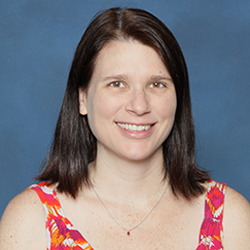
Candice Fazar, Ph.D.
Associate Professor of PhysicsEducation
Ph.D. in Physics, University of Rochester, Rochester, NY (March 2007) Dissertation: Development of Long Wave Infrared Detectors for Space Astronomy Adviser: Dr. Judith Pipher
M.A. in Physics, University of Rochester, Rochester, NY (May 2001)
B.A. in Physics and Musical Studies, Bethel College, St. Paul, MN (May 1999) Summa Cum Laude
Biography
“ All our dreams can come true, if we have the courage to pursue them. ” – Walt Disney
Dr.Fazar grew up as number four in a blended family of ten children. She enjoys traveling, especially visiting family in Minnesota when she gets the chance. She loves exploring non-inertial reference frames on roller-coasters and putting up multi-frequency photon emitters at Christmas time. She is also a fantastic π maker. Her favorite place in the world is Walt Disney World in Orlando, Florida, and she hopes to explore the physics of movies and entertainment there someday with a group of her favorite students.
Professional Affiliations
SPS – Society of Physics Students – Students who have taken 3+ semesters of physics are eligible to become a part of this group of students. This group has had a few events since its induction in the summer of 2009 with pizza movie parties and a trip to an AAPT (American Association of Physics Teachers) conference in the fall of 2009. Gain access to scholarships, opportunities and camaraderie by joining us!
AAPT – American Association of Physics Teachers
Scholarships, competitions and Physics and photography
AIP – American Institute of Physics
Want to know what you can do with a physics degree?
APS – American Physical Society
Math, science, history… unraveling the mystery
SPIE – Society for optics, photonics and imaging engineering
Research
Characterization of 10.3 μm cutoff HgCdTe Detector Array. University of Rochester, July-August 2009.
Contracted to characterize diode behavior of a HgCdTe detector array for a proposal by JPL NASA. Developed theories explaining dislocation induced and/or enhanced surface and tunneling dark currents exhibited by the device diodes. Delivered a twenty page paper characterizing the device and explaining the theories in detail to JPL.
Doctoral Research. University of Rochester, 2000-2007. Contributed to the development of long wave infrared detector arrays for space based astronomy in the following ways: Characterized diode behavior by modeling with material parameters, experimentally determined best diode configuration for LWIR space application, developed programs in Interactive Data Language (IDL) to characterize the dark current for each pixel in an array, detected and investigated the presence of burst noise in the source-follower unit cell FET, developed programs in IDL to characterize the phenomenon, and investigated how to correct for and prevent burst noise. Adviser: Dr. Judith Pipher, Department of Physics and Astronomy
Research Assistant. Detector Physics, University of Rochester, July 1999-2000. Investigated ‘black hole’ phenomenon due to erroneous signals during temperature fluctuations of InSb detector arrays for Spitzer Space Telescope. Adviser: Dr. Judith Pipher, Department of Physics and Astronomy
Publications
C. M. Bacon, J. L. Pipher, W. J. Forrest, C. W. McMurtry, and J. D. Garnett, “Diode Characterization of Rockwell LWIR HgCdTe Detector Arrays,” in Proc. SPIE, IR Space Telescopes and Instruments., J. C. Mather, ed., 4850, pp. 927-934, 2003.
C. M. Bacon, J. L. Pipher, W. J. Forrest, C. W. McMurtry, J. D. Garnett, D. Lee, and D. D. Edwall, “Characterization of Rockwell Scientific LWIR HgCdTe Detector Arrays,” in Proc. SPIE, Focal Plane Arrays for Space Telescopes., T. J. Grycewicz and C. R. McCreight, eds., 5167, pp. 313-319, 2004.
C. M. Bacon, C. W. McMurtry, J. L. Pipher, W. J. Forrest, J. D. Garnett, D. Lee, and D. D. Edwall, “Further Characterization of Rockwell Scientific LWIR HgCdTe Detector Arrays,” in Proc. SPIE, Infrared Systems and Photoelectronic Technology., E. L. Dereniak, R. E. Sampson and C. B. Johnson, eds., 5563, pp. 35-45, 2005.
C. M. Bacon, C. W. McMurtry, J. L. Pipher, W. J. Forrest, J. D. Garnett, “Burst Noise in the HAWAII-1RG Multiplexer,” in Proc. SPIE, Focal Plane Arrays for Space Telescopes II., T. J. Grycewicz and Marshall, eds., 5902, 2006.
C. M. Bacon, “Development of Long Wave Infrared Detectors for Space Astronomy”, Ph.D. Dissertation, University of Rochester, 2007.
C. M. Bacon, C. W. McMurtry, J. L. Pipher, A. Mainzer, and W. Forrest, “Effect of dislocations on dark current in LWIR HgCdTe photodiodes,” in Proc. SPIE, High Energy, Optical, and Infrared Detectors for Astronomy IV, A D. Holland and D. A. Dorn, eds., 7742, 2010.
Courses Taught
Introductory Courses
For Non-Majors
- PHY 101 – General Physics I – Introductory trigonometry based physics course typically taken by health science majors.
- PHY 102 – General Physics II – Second semester introductory trigonometry based physics course.
For Majors
PHY 201 – Physics for Engineers and Scientists I – Calculus based physics course exploring conservation laws and newton’s laws of motion. Typically taken by physics, math and chemistry majors as well as those interested in engineering.
PHY 202 – Physics for Engineers and Scientists II – Second semester in the calculus based physics sequence exploring electricity and magnetism, relativity and optics.
- PHY 203 – Physics for Engineers and Scientists II – Third semester in the calculus based physics sequence exploring quantum physics, thermodynamics and the connection between faith and science.
Engineering Courses
- PHY 211 – Electric Circuits – Engineering driven course that studies the behavior of electrical circuits. Typically taken by students interested in engineering.
Upper Level Science Courses
PHY 301 – Classical Mechanics – Explores the motion of macroscopic objects (such as baseballs and pendulums) incorporating advanced ideas such as drag and the rotation of the earth. Typically taken by physics majors and interested mathematicians.
PHY 302 – Electricity and Magnetism – Studies the interaction between various combinations of stationary and moving charged particles. Typically taken by physics majors.
PHY 303 – Optics – Investigates the sources and behavior of electromagnetic waves (AKA light). Typically taken by physics majors and interested others.